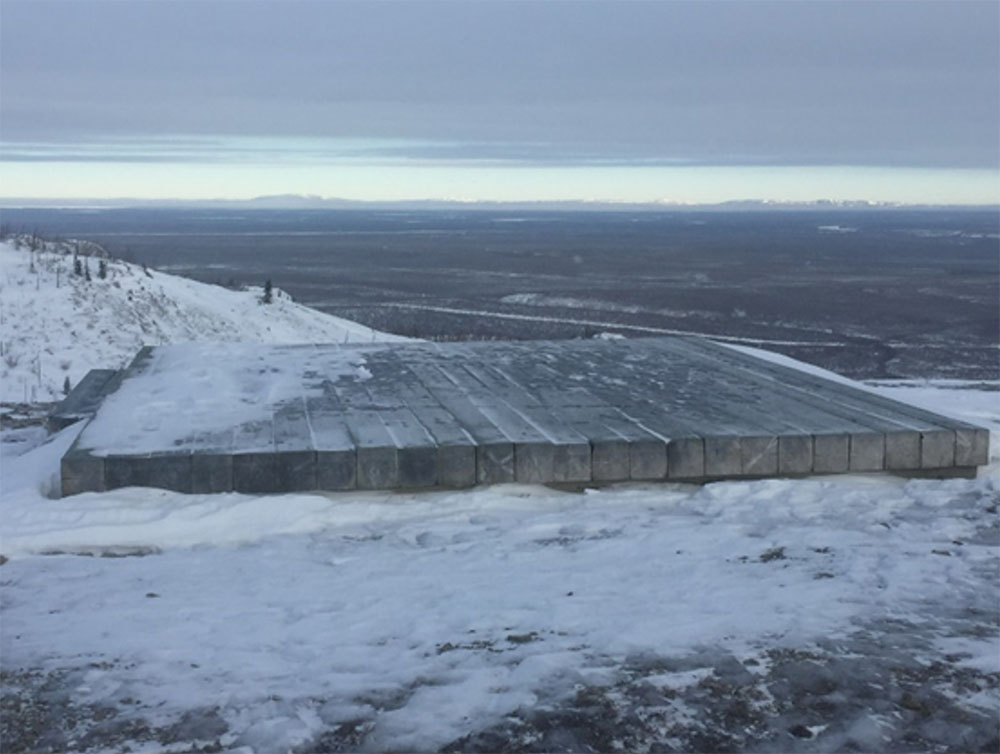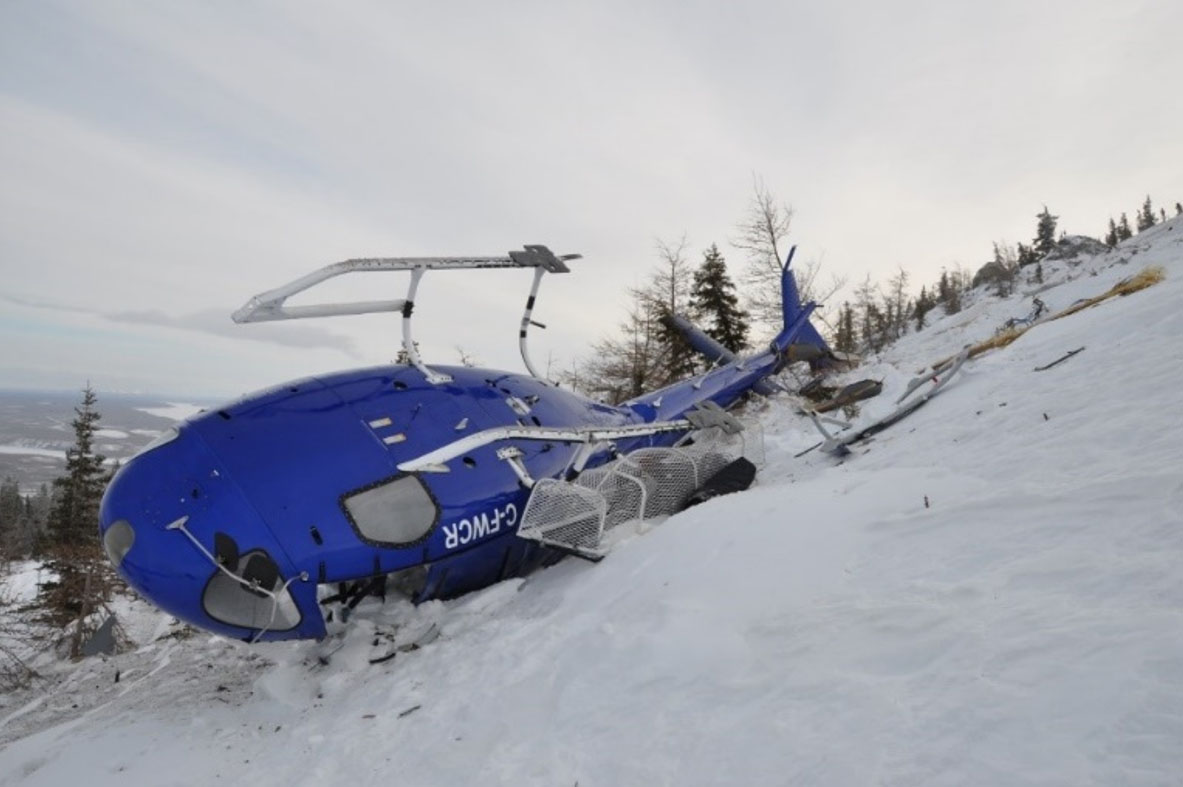Collision with terrain
Sahtu Helicopters Ltd.
Airbus Helicopters AS 350 B2, C-FWCR
Tulita, Northwest Territories, 3 nm WNW
The Transportation Safety Board of Canada (TSB) investigated this occurrence for the purpose of advancing transportation safety. It is not the function of the Board to assign fault or determine civil or criminal liability. This report is not created for use in the context of legal, disciplinary or other proceedings. See Ownership and use of content. Masculine pronouns and position titles may be used to signify all genders to comply with the Canadian Transportation Accident Investigation and Safety Board Act (S.C. 1989, c. 3).
History of the flight
At 0939Footnote 1 on 15 February 2018, the Sahtu Helicopters Ltd.Footnote 2 Airbus Helicopters AS 350 B2 (registration C-FWCR, serial number 2204) departed Norman Wells Airport (CYVQ), Northwest Territories, with the pilot and 1 passenger on board. The purpose of the flight was to transport the passenger to a telecommunications tower on Bear Rock, Northwest Territories, which is located 35 nautical miles (nm) southeast of Norman Wells, and 3 nm west-northwest of Tulita, Northwest Territories.
At 0958, the helicopter landed on a helipad near the telecommunications tower and was shut down. The helipad, measuring 16 feet by 16 feet, is made of treated timber and is located 165 feet from the telecommunications tower service building. At the time of the occurrence, the helipad was mostly bare wood; however, there were several patches of ice (Figure 1).
Approximately 30 minutes after landing, given the temperature at the time, the pilot conducted a first engine run as per the AS 350 B2 flight manual supplement Instructions for Operation in Cold Weather, because pre-heatFootnote 3 was not available. On start-up, the pilot felt vibrations consistent with those felt over the previous 3 days, both on the ground and during flight.
At 1108, the pilot initiated the engine-start sequence for another engine run. The engine started and accelerated normally to 70% gas generator speed (Ng). The pilot increased the fuel flow control to the flight position. As the throttle was increased, the helicopter began bucking fore and aft on the landing gear skids.
In response, the pilot decreased the fuel flow control, which increased the bucking. The pilot then decided to lift off in order to stop what he perceived to be ground resonance. The fuel flow control was quickly increased and the collective raised; however, the fuel flow control was not fully advanced and locked into the flight gate. Neither the main rotor rpm nor the engine rpm accelerated to the flight-governing range before the helicopter became airborne.
The helicopter lifted several feet off the helipad, rotated to the left, and drifted approximately 30 m to the southeast. Given that the engine rpm had not accelerated into the flight-governing range, the rotor rpm subsequently drooped,Footnote 4 and the pilot was unable to maintain control of the helicopter.
At approximately 1110, the helicopter descended, collided with terrain and came to rest 50 m downslope of the helipad (Figure 2). The emergency locator transmitter did not activate. The engine remained running for a short while, then shut down on its own.
The pilot was wearing the 4-point lap and shoulder harness, but was not wearing a helmet. He received serious injuries, but managed to egress the helicopter, return to the telecommunications tower service building, and contact the company to report the accident. The passenger who had been transported to the telecommunications tower administered first aid to the pilot. A company helicopter was dispatched from Fort Simpson, Northwest Territories, and arrived at approximately 1500 to transport the pilot to medical facilities in Yellowknife, Northwest Territories.
Weather
The Tulita hourly weather observation taken at 1100 (10 minutes prior to the accident) reported calm winds (at 3 knots), visibility greater than 25 statute miles with light snow, and a temperature of −27 °C.
Pilot
Records indicate that the pilot was certified and qualified for the flight in accordance with existing regulations. The pilot held a commercial pilot licence – helicopter and a valid category 1 medical certificate. He had received annual training on the AS 350 in January 2018 and had a total of 5277 hours flight time, 2017 hours of which were on the AS 350. At the time of the accident, the pilot had flown 6.5 hours on AS 350 helicopters in the previous 7 days, and 11.7 hours in the previous 30 days.
Aircraft
The AS 350 B2 is equipped with a single engine and has a maximum take-off weight of 2250 kg (4960 pounds). The occurrence helicopter was manufactured in 1989 and was equipped for day visual flight rules and single-pilot operation.
At the time of the occurrence, the helicopter had accumulated approximately 11 005 hours of air time and 46 214 cycles. The helicopter was being operated within its weight-and-balance and centre-of-gravity limits.
Sahtu Helicopters Ltd. operated a 2nd helicopter out of CYVQ, which was serviceable and available at the time of the occurrence.
Ground resonance
Ground resonance (oscillation divergence) is a self-excited vibration on helicopters with articulatedFootnote 5 rotor systems. It generally occurs on the ground during landing or rotor-starting phases. As described in the U.S. Federal Aviation Administration (FAA) Helicopter Flying Handbook, Ground resonance is a mechanical design issue that results from the helicopter’s airframe having a natural frequency that can be intensified by an out-of-balance rotor.Footnote 6 The unbalanced rotor system vibrates at the same frequency or multiple of the airframe’s resonant frequency and the harmonic oscillation increases because the engine is adding power to the system, increasing the magnitude (or amplitude) of the vibrations [...].Footnote 7
If left uncorrected, it can become severe and damage the airframe structure.
According to guidance in the FAA’s Helicopter Flying Handbook, when ground resonance is experienced during low engine rpm,
the only corrective action [...] is to close the throttle immediately and fully lower the collective to place the blades in low pitch. If the rpm is in the normal operating range, fly the helicopter off the ground, and allow the blades to rephase themselves automatically.Footnote 8
The AS 350 B2 flight manual does not contain ground resonance handling procedures.
Main rotor head
Ground resonance does not normally occur in rigidFootnote 9 or semi-rigidFootnote 10 rotor systems because there is no drag hinge.Footnote 11 The AS 350 series of helicopters is equipped with a Starflex rotor head, which consists of many composite components and elastomeric parts (thrust bearings). The Starflex rotor head is known as an articulated rotor head.
The Starflex rotor system does not use lead-lag dampers. Rather, blades are able to move in the lead-lag axis due to the rotor’s articulation. To increase dampening along this axis of movement, the Starflex architecture uses elastomeric frequency adapters to dissipate lead-lag energy.
During the impact sequence in this occurrence, the main rotor head was significantly damaged. Two of the 3 frequency adapters were recovered from the accident site. Examination of the rotor head components did not identify any indications of pre-impact failure.
Landing gear
AS 350 series helicopters are equipped with 2 systems on the landing gear skid assembly that absorb vibrations:
- Flexible steel strips: These are bent downwards, extending from the rear part of the landing gear skids. The steel strips increase the landing gear skid flexibility and position the natural frequency of the landing gear skid in such a way as to reduce ground resonance.
- Damper assemblies: These are mounted on the front cross-tube of the landing gear skids, between the skid’s forward flexible cross-leg and the helicopter fuselage. The dampers are intended to absorb the vibration energy and reduce oscillation divergence.
The occurrence aircraft was equipped with both of these systems. It is unknown if the flexible steel strips on the aft end of the helicopter skids landed on the bare wood or on the ice patches on the helipad.
On the landing gear damper assemblies (part number 350A75-2050-06), the left damper had 3001.1 hours total time since installation, and the right damper had 1395.3 hours total time since installation. Following the accident, on 24 February 2018, the operator removed the landing gear damper assemblies for inspection and testing, which were conducted by the maintenance organization’s in-house component shop.
The damper assemblies were functionally tested. The left damper passed the test but the right damper did not. The right damper was disassembled, cleaned, and reassembled with new packings, seals, and washer valves. Following reassembly, the right damper was re-tested and was found to be serviceable.
Main rotor blade removal and installation
On 11 February 2018, 4 days before the accident, the helicopter was placed in the Great Slave Helicopters Ltd.Footnote 12 hangar overnight. An aircraft maintenance engineer had removed the main rotor blades with the assistance of the occurrence pilot and placed them on a wheeled storage rack, which was positioned beneath the helicopter tail boom after the helicopter was placed in the hangar.
After reinstalling the main rotor blades on the morning of 12 February 2018, the occurrence pilot conducted an engine run, during which vibrations were noted. The vibration levels were not verified using vibration analysis equipment, which was available at the maintenance hangar. The blade tip tracking and dynamic balancing were not checked, as prescribed in the aircraft maintenance manual.Footnote 13 ,Footnote 14
When this type of work is carried out, the Canadian Aviation Regulations and company policies require that an entry be made in the aircraft journey log; however, no entry was made in the aircraft journey log for either the removal or the installation of the rotor blades. The investigation found that it was the maintenance provider’s routine practice to do this type of work without making entries in the aircraft journey log.
The pilot subsequently flew the helicopter for 6 hours before the occurrence and the vibration continued. During this time, no action was taken to verify or rectify the vibration and no aircraft journey log entries were made.
Information on the pre-accident tracking and balance condition of the rotor system was not available (because it was not recorded by maintenance) and was impossible to obtain post-accident.
Key safety messages
The investigation highlighted the following safety messages:
- The success of recovery when encountering possible ground resonance depends on appropriate action relevant to the main rotor speed.
- It is important to record maintenance activities in the aircraft journey log and follow maintenance procedures, for example when removing and installing main rotor blades.
- Wearing the available lap and shoulder harnesses and a helmet is key to preventing injury in rollover accidents in which the potential for head injury is high.
Safety action taken
Following this accident, the following safety actions were taken:
- On 26 June 2018, Great Slave Helicopters Ltd. management sent an email to all company pilots and aircraft maintenance engineers, reminding them of the requirement to enter blade removal and installation in the aircraft journey log.
- An audit cycle was added to monitor the blade removal and installation events.
- Company pilots were reminded, in recent training classes, of the requirement to record any sudden changes in vibration levels in the aircraft journey log.
This concludes the TSB’s limited-scope investigation into this occurrence. The Board authorized the release of this investigation report on . It was officially released on .

